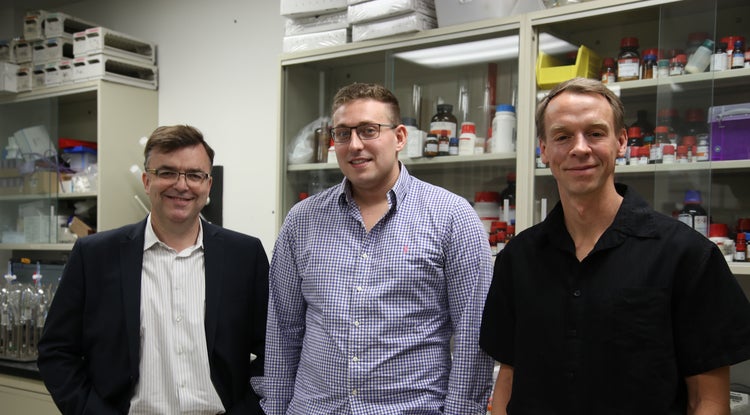ASU researchers developing pioneering drug to treat Alzheimer's disease in Down syndrome patients

When a baby is born, each cell in his or her body contains 23 pairs of chromosomes, or 46 chromosomes in total, with half coming from each parent. At least, this is the case for most of us.
The biological machinery responsible for assuring proper chromosome distribution can sometimes go awry. This can result in a range of serious genetic diseases, the most common of which is known as Down syndrome. In this case, an extra copy of chromosome 21 is inherited from one parent. The condition is also known as Trisomy 21.
In addition to an array of purely physical abnormalities, virtually all Down syndrome patients develop Alzheimer’s disease, usually between the ages of 40 and 50. There are no available treatments to prevent or mitigate the progression to Alzheimer’s disease for these individuals.
However, Arizona State University researcher Travis Dunckley and University of Arizona Professor Christopher Hulme and their colleagues have developed a candidate drug they hope may successfully block the development or advancement of Alzheimer’s disease in Down syndrome patients. The drug acts by decreasing the levels of Dyrk1a, a particular type of enzyme known as a kinase, which is overexpressed in Down syndrome patients.
“This particular kinase seems to be involved in a lot of the cognitive deficits of Down syndrome, and particularly in the early-onset Alzheimer's disease of Down syndrome,” says Dunckley, assistant research professor with the ASU-Banner Neurodegenerative Disease Research Center.
Dunckley and Hulme have founded a startup company to push the new drug through additional studies and develop it for human use. The company, Iluminos Therapeutics, LLC, has received a three-year, $3.5 million federal Small Business Technology Transfer grant to test the latest iteration of the drug in a mouse model and perform IND-enabling studies, thereby positioning the compound for clinical trials.
If successful, the drug will be a medical milestone for those with Down syndrome. It also may represent a new approach to the treatment of late onset Alzheimer’s disease, the most common form of dementia in the general population. The methodology may eventually be applied to other neurodegenerative diseases as well.
Illuminos team (from left to right): Chris Hulme, graduate researcher James Foley, Travis Dunckley.
Genesis of Down syndrome
Many of the abnormalities associated with Down syndrome are believed to derive from a particular area of chromosome 21, known as the Down syndrome critical region. This portion of the chromosome contains a cluster of genes whose overexpression has been linked with telltale characteristics of the disease, including craniofacial abnormalities and peripheral organ dysfunction, as well as the seeds of Alzheimer’s disease.
The design of the new drug was completed over a 10-year period by Hulme, an industry trained medicinal chemist with expertise in developing drugs that inhibit the function of kinases. Ramon Velazquez, an assistant professor also with the Neurodegenerative Disease Research Center, will conduct tests on mouse models of the new kinase inhibitor drug.
Kinases are important regulatory enzymes in the body that add chemicals known as phosphates to other proteins. This process of phosphorylation is critical to many life processes, playing a vital role in embryonic development. In Down’s syndrome, however, an over-phosphorylation of critical proteins can induce three classic hallmarks of Alzheimer’s disease.
When a protein known as the amyloid beta precursor protein is hyperphosphorylated by Dyrk1a, it results in the accumulation of amyloid beta plaques in the brain. The hyperphosphorylation of another protein known as Tau results in neurofibrillary tangles within the cell bodies of affected neurons.
Dunckley and his colleagues have also demonstrated that the hyperphosphorylation activity caused by Dyrk1a is linked with neuroinflammation, a characteristic common across neurodegenerative diseases, including Alzheimer’s disease. The research shows overexpression of Dyrk1a is linked with elevated levels of an inflammatory cytokine known as TNF alpha.
A multi-pronged approach
The new drug is particularly exciting because it acts to inhibit Dyrk1a, thereby targeting multiple pathways of neurodegeneration. For this reason, it could potentially break the logjam of existing drug therapies, which typically target just one symptom, often after Alzheimer’s disease has already irreparably ravaged the brain.
As Dunckley notes, the new insights into the relationship between Dyrk1a overactivity and telltale symptoms of Alzheimer’s disease are the culmination of a long path of investigation and discovery.
“About 15 years ago, I wanted to try to identify new proteins responsible for Tau hyperphosphorylation, and through a series of high-throughput screens, we came upon this Dyrk1a kinase as being important in the process.”
In Down syndrome, the hyperphosphorylation caused by Dyrk1a is an inevitable consequence of the chromosome triplication produced by the disease, including triplication of the Down syndrome critical region, where the Dyrk1a kinase gene resides.
Modeling disease
The research team will use a mouse model of Down syndrome to test a new version of the Dyrk1A kinase inhibitor they have spent years refining.
“Dyrk1a protein levels are elevated in human brain tissue of Down syndrome individuals and in the Down syndrome mouse model, suggesting that it may in fact play a role in regulating various pathogenic mechanisms. These include tau and amyloid beta pathology as well as inflammation, all of which are seen in patients with Down syndrome and Alzheimer’s disease,” Velazquez says. “Having a drug that potentially ameliorates these pathologies in Alzheimer's disease but also for patients with Down syndrome is highly motivating.”
The researchers will investigate the effects of various dosages of the experimental drug on Alzheimer’s pathology on mouse models, as well as its ability to improve cognitive aspects associated with the disease, including spatial learning and memory.
Design improvements to the kinase inhibitor have enhanced the drug in several ways. The latest version is highly potent and shows high selectivity, meaning it can narrowly distinguish the Dyrk1a kinase from most of the other 500 or so kinases in the body. The inhibitor has a long half-life in the brain of about four hours and shows 100% bioavailability.
Phase one of the project will establish the efficacy of the kinase inhibitor in a mouse model relevant to Down syndrome. The next phase will establish that the drug is safe for human use. Because the first human recipients of the drug are likely to be adolescents with Down syndrome, the drug must meet a very high bar for safety. Once achieved, however, this safety profile should later help secure FDA approval for broader use of the drug to treat Alzheimer’s in the general population.
Top image courtesy of iStock.com.
More Science and technology

ASU professor honored with prestigious award for being a cybersecurity trailblazer
At first, he thought it was a drill.On Sept. 11, 2001, Gail-Joon Ahn sat in a conference room in Fort Meade, Maryland. The cybersecurity researcher was part of a group that had been invited…

Training stellar students to secure semiconductors
In the wetlands of King’s Bay, Georgia, the sail of a nuclear-powered Trident II Submarine laden with sophisticated computer equipment juts out of the marshy waters. In a medical center, a cardiac…

ASU startup Crystal Sonic wins Natcast pitch competition
Crystal Sonic, an Arizona State University startup, won first place and $25,000 at the 2024 Natcast Startup Pitch Competition at the National Semiconductor Technology Center Symposium, or NSTC…
